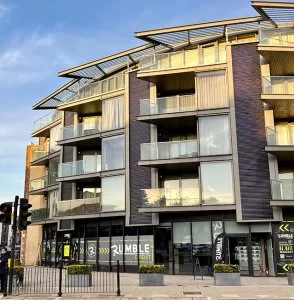Commercial Rent Arrears Recovery (CRAR)
Expert support through the CRAR process
Commercial Rent Arrears Recovery is a fast solution for commercial landlords wanting to avoid costly litigation when their tenant falls behind on rent. The requirements are strict, so it is vital you get the best possible advice from real experts in this area.
Table of Contents
What is commercial rent arrears recovery?
Commercial Rent Arrears Recovery (CRAR) is a legal rent recovery process. It allows commercial landlords to recover unpaid rent from their tenants by “seizing and selling” the tenant’s goods.
This procedure was introduced in April 2014, replacing the old common law remedy of distress.
CRAR provides a clear and efficient way for landlords to collect outstanding rent when tenants have fallen behind on rent payments for at least seven days. However, there is a significant amount of red tape around the process to prevent abuse of the system.
Before you proceed with CRAR, it is vital that you take expert legal advice. Our commercial property litigation lawyers can advise on whether CRAR is appropriate in your specific situation and help ensure the procedure is carried out correctly and legally.
Who can use commercial rent arrears recovery?
Under CRAR, a landlord instructs a Certificated Enforcement Agent (a type of bailiff) to enter the leased property and seize goods belonging to the tenant. Those goods are then sold to pay the rent arrears.
Landlords can use CRAR:
- Only for “pure” rent (service charge and insurance cannot be recovered, even if they are reserved as rent under the lease).
- Only for commercial property (not residential or mixed-use properties, unless the residential part of the mixed-use property has its own separate entrance).
- If the rent arrears amount to at least seven days’ unpaid rent.
- If there is a written lease between landlord and tenant (oral agreements do not qualify).
- Only if the landlord has not yet issued other proceedings against the tenant, such as a debt claim or forfeiture.
What is the commercial rent arrears recovery procedure?
CRAR is not a self-help remedy—landlords cannot enter the property and seize goods themselves. You can only initiate the CRAR process by instructing a Certified Enforcement Agent (EA), who will carry out the following process for you:
- Give the authorised agent permission to act.
Once you have found a certificated EA, you will need to complete a Warrant of Control form. This gives the EA permission to act on your behalf. The form contains a written statement of how much rent is due, including costs and legal fees.
- Serve notice on the tenant.
The EA will serve notice on the tenant, giving the tenant seven days to pay the rent arrears. If the tenant pays the full amount within this time frame, you will be unable to continue with CRAR.
In some situations, it may be possible to require a sub-tenant to clear the tenant’s rent arrears directly, using a procedure very similar to CRAR. The sub-tenant must be given 14 days’ notice instead of 7.
- Entry and seizure.
If the tenant fails to pay within those seven days, the EA can enter the property through an open or unlocked door during normal business hours (6 am – 9 pm). Once inside, they can seize goods belonging to the tenant to the equivalent value of rent they owe (plus costs) and no more.
Only certain types of goods can be seized, and the EA must provide the tenant with a full inventory of everything they have taken.
Enforcement does not have to be carried out as soon as the seven days’ notice is up. In fact, EAs have up to 12 months from the date of the notice to complete this process. The right to enforce will fall away if the tenant pays up in the meantime.
- Sale of goods
The goods will be sold, usually at a public auction, to pay off the rent arrears. Tenants must be given at least seven days’ notice ahead of any sale, although you can apply to the court to reduce this period if the value of the goods would drop in the meantime. Where there are any funds left, these will go to the tenant.
Can the tenant hide their goods after receiving a CRAR notice?
By law, the tenant is not allowed to sell or remove goods from the property once a notice of enforcement has been issued. However, that does not stop landlords from worrying that 7 days’ notice is more than enough time for the tenant to put their high-value goods out of reach of the bailiffs.
Where it is reasonable to believe that a tenant will remove its valuable goods from the premises, you can ask the court for a shorter notice period. A solicitor experienced in the CRAR process can advise you on the best course of action.
What are a tenant’s rights in a commercial rent arrears recovery?
Tenants cannot physically resist the EA or any court bailiffs who are lawfully entering the premises to seize goods.
However, once the 7-day notice has been served, they can ask the court to either set aside or delay the execution of the CRAR process on the basis that the tenant is trying to pay back the arrears.
One common outcome is for the tenant to enter into a controlled goods agreement to repay what the tenant owes over time. Under a CGA, the “seized” goods stay on the premises on the proviso that the EA can remove and sell them if the tenant does not keep up its payment plan.
What are the alternatives to commercial rent arrears recovery?
CRAR is faster and cheaper than conventional litigation, and the threat of a goods seizure is often enough to prompt a commercial tenant to pay up.
However, there are some risks:
- The goods seized may not cover all the rent arrears. Some businesses have very few assets, and others may have valuable goods that are not owned by the tenant but rather a hire purchase or rental company. In these cases, CRAR will not be successful in recovering the rent arrears.
- CRAR will waive any right to forfeit the lease. It’s important to weigh up all your options with a solicitor before initiating the CRAR process. There may be other breaches, such as non-payment of service charge, for which forfeiture could be a more appropriate remedy.
- Longer-term issues. While CRAR will deal with rent arrears up to the date of enforcement, it will not reduce the risk of default happening again. Rent arrears are often a sign of deeper financial problems with the tenant, so it may be worth considering other remedies that will give you more control over the situation.
In such situations, landlords may want to consider other options such as:
- Drawing from a rent deposit.
- Pursuing a guarantor.
- Issuing a statutory demand for payment.
- Taking the tenant to court to recover the rent arrears.
- Forfeiting the lease and evicting the tenant by serving a Section 25 notice.
Need guidance on commercial rent arrears recovery?
The laws around commercial rent arrears recovery are stringent, but we are here to make everything as straightforward as possible for you. Our aim is to recover what is owed to landlords quickly and with as little fuss as possible. But if more serious steps are required, we will be by your side.
For tenants who have received a CRAR notice and want to dispute the amount owed or negotiate repayment terms, our highly experienced property litigation solicitors can provide expert assistance.
To speak with one of our solicitors, contact us by:
- Filling in our online enquiry form; or
- Calling us on 020 7485 8811
Shilpa really helped us take charge of the situation and helped resolve this property dispute. I would not hesitate to recommend her or the team to anyone in a similar situation.
On first meeting Shilpa I was sure that she understood immediately my requirements, and was sympathetic both to my financial restraints and my emotional state. She achieved everything I asked of her and proved to be invaluable, professional and efficient
At every step Shilpa alleviated any concerns and stresses we had. Always fast to respond, always professional and super knowledgeable.
Shilpa has helped us through some key property litigation matters (residential and commercial) since 2014 and has delivered on every occasion. One particular issue had kept us in a state of stress and tension for almost a decade and after getting in touch with Shilpa she was able to help us bring the matter to a peaceful and successful conclusion.
I received a call from Shilpa Mathuradas a couple of hours after filling the enquiry form for a callback. She actively listened to my party wall concerns responding with gentle professionalism, answering my concerns, letting me know what is and is not possible and when best to bring in a solicitor. All this within 10 minutes. Excellent.
"They are an outstanding firm to work with. They are consistently impressive in their work."
Excellent in every aspect.
If I had another reason to have to seek legal advice again, I wouldn’t hesitate to use Shilpa, and would recommend her to anybody who needed legal advice.
Shilpa was professional, realistic, and unflappable. Shilpa managed to persuade a reluctant witness to come forward to support my case. She obviously knows her subject very well.
I always had full confidence in Shilpa keeping my best interests at heart. I often didn’t understand the legal language, and she would follow this up with a phone call and patiently explain.
Property News & InsightsVIEW ALL
- 5.3.2025
TOLATA Claim Settled At Mediation
Complex TOLATA claim settled after an extensive mediation We recently settled at mediation, a complex TOLATA case involving a dispute...
Read more - 4.12.2024
Security of Tenure
Security of tenure gives business tenants the right to stay in their property after the lease ends and request a...
Read more - 4.12.2024
Section 25 Notices
A Section 25 notice plays an important role in commercial leases, letting landlords and tenants know what’s next when a...
Read more - 4.12.2024
Section 21 Notices
Guide to section 21 no-fault evictions Evicting tenants is never easy but under the no-fault eviction process, it should be less...
Read more - 18.11.2024
Rent Repayment Orders
Guidance for Rent Repayment Orders (RROs) for Landlords in the UK Rent Repayment Orders (RROs) are legal orders requiring a...
Read more - 13.11.2024
Evicting a Tenant
How to evict a tenant: Guidance for landlords Evicting tenants is rarely straight forward. It is a challenging and complex...
Read more - 16.10.2024
Managing Litigants: Court Powers and Defendant Options
How can the court control a litigant? Most people wish to live out their lives without the need to face...
Read more - 15.10.2024
How do you determine a boundary?
Whether the boundary dispute relates to a rear garden boundary or whether it relates to a driveway, the issue of...
Read more - 14.10.2024
Can You Challenge a Restrictive Covenant?
Challenging a restrictive covenant! Is it obsolete? It is well known that section 84(1) of the Law of Property Act 1925 allows...
Read more - 22.3.2024
The Renters Reform Bill
A Review of the Renters Reform Bill The 2019 Conservative Manifesto made a commitment to end “no fault evictions”. This has...
Read more - 22.3.2024
Client successful in TOLATA proceedings
The case related to proceedings under the Trusts of Land and Appointment of Trustees Act 1996 (“TOLATA”) in respect of joint...
Read more - 23.1.2024
Freehold Service Charge Disputes
Service Charges & the Leasehold and Freehold Reform Bill The Leasehold and Freehold Reform Bill was introduced to Parliament on 27...
Read more - 23.1.2024
Know your Rights (of Way)
If you have a question or concern over a right of way on your property, it is important to seek...
Read more - 23.1.2024
Party Wall Etc Act 1996 v Common Law
The case of Power & Kyson & Shah [2023] EWICA Civ 239 The case of Power & Kyson & Shah [2023] EWICA Civ 239...
Read more - 27.10.2023
The Building Safety Act 2022
Introduction to the Building Safety Act 2022 This much awaited Building Safety Act 2022 was introduced into Parliament on 5th May 2021 as...
Read more - 22.8.2023
Reasonableness of Service Charges
Reasonableness of Service charges under the Landlord and Tenant Act 1985 It is well known that the relevant costs that a...
Read more - 11.5.2023
Overlooking Nuisance Claims
The Supreme Court’s Ruling on Overlooking as Private Nuisance In the case Fearn v Tate (2023) UKSC 4, the UK Supreme...
Read more - 5.2.2023
Japanese Knotweed: Knot in my backyard again!
Huge legal bill after selling home with Japanese knotweed Many will have read the recent case in which a furniture...
Read more - 9.6.2022
TOLATA Claims
What is a TOLATA claim? A TOLATA claim is a legal process under the Trusts of Land and Appointment of...
Read more - 8.6.2022
Right to Light Explained
What is the Right to Light? The right to light is a type of ‘easement’ – a legal right giving property...
Read more - 8.6.2022
The Dangers of Rent-to-Rent
What is Rent-to-Rent? Rent-to-Rent refers to the practice of landlords letting a whole property to a tenant (usually a limited...
Read more - 5.10.2021
Buying a Property with a Party Wall Agreement
Introduction to buying a house with a party wall agreement Buying a property can already be stressful, but finding out...
Read more - 10.8.2021
Beneficial Interest in Property
What does beneficial interest in property mean? A beneficial interest in property gives someone the right to share the benefits...
Read more - 26.6.2021
The Risks Of Buying Properties Off Plan!
Buying Property Off Plan The Daily Mail reported that 300 families a week have to move into shoddy newly built homes....
Read more
The Property Litigation Team View the whole team
William Ford
 Partner
Partner
Housing and Social CareShilpa Mathuradas
 Partner
Partner
Property LitigationMuna Adam
 Solicitor
Solicitor
Property LitigationJames Mayall
 Solicitor
Solicitor
Property LitigationEllie McEvoy
 Paralegal
Paralegal
Property LitigationAlex McMahon
 Senior Associate
Senior Associate
Housing and Social CareLeopoldine Mineo
 Solicitor
Solicitor
Property LitigationAlex Panayi
 Solicitor
Solicitor
Property LitigationHeena Shah
 Solicitor
Solicitor
Property LitigationAnna Van-Haute
 Paralegal
Paralegal
Property LitigationView the
whole team



























